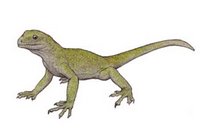 If you go back about 330 million years, there were no birds or people. If you could do your genealogy back that far, you would find that you shared ancestors with birds. These ancestors were four-legged animals similar to the fossils Westlothiana and Casineria. By about 313 million years ago, birds and humans still shared the same ancestors, amniotes similar to Protoclepsydrops and Hylonomus. (Image of Hylonomus from here, more images here)
If you go back about 330 million years, there were no birds or people. If you could do your genealogy back that far, you would find that you shared ancestors with birds. These ancestors were four-legged animals similar to the fossils Westlothiana and Casineria. By about 313 million years ago, birds and humans still shared the same ancestors, amniotes similar to Protoclepsydrops and Hylonomus. (Image of Hylonomus from here, more images here) By 309 to 302 million years ago, the ancestors of birds had separated from our ancestors to become a distinct lineage that would include lizards, crocodiles, dinosaurs and birds. These early bird ancestors were similar to Petrolacosaurus, (image from here, more images here) , the oldest known diapsid reptile, which hales from the Rock Lake Shale of the Stanton Formation near Garnett, Kansas (perhaps to the chagrin of people in that state with other views about the origins of birds).
By 309 to 302 million years ago, the ancestors of birds had separated from our ancestors to become a distinct lineage that would include lizards, crocodiles, dinosaurs and birds. These early bird ancestors were similar to Petrolacosaurus, (image from here, more images here) , the oldest known diapsid reptile, which hales from the Rock Lake Shale of the Stanton Formation near Garnett, Kansas (perhaps to the chagrin of people in that state with other views about the origins of birds). Our own ancestors at this time were more similar to Protoclepsydrops and Archaeothyris (image from here), some of the earliest synapsids. As you can see from these images, the ancestors of both birds and humans were pretty much lizard-people (perhaps another reason I always liked lizards?).
Our own ancestors at this time were more similar to Protoclepsydrops and Archaeothyris (image from here), some of the earliest synapsids. As you can see from these images, the ancestors of both birds and humans were pretty much lizard-people (perhaps another reason I always liked lizards?).  Over the past 300 million years, the descendents of Protolepsydrops and Petrolacosaurus have gone their separate evolutionary ways, though sharing the planet the entire time. Looking back now over perhaps 300 million generations of birds, and perhaps just a few million fewer generations of diapsids, mammals, primates, and humans, its perhaps easier to think that we are very different from each other. While in many ways this is true, part of the joy of living with birds is the quest to determine how much we share with our distant kin, as well as to wonder how our two different lineages could have given rise to so many wonderful creatures after separating from each other back in the Carboniferous. (Owl photo: here)
Over the past 300 million years, the descendents of Protolepsydrops and Petrolacosaurus have gone their separate evolutionary ways, though sharing the planet the entire time. Looking back now over perhaps 300 million generations of birds, and perhaps just a few million fewer generations of diapsids, mammals, primates, and humans, its perhaps easier to think that we are very different from each other. While in many ways this is true, part of the joy of living with birds is the quest to determine how much we share with our distant kin, as well as to wonder how our two different lineages could have given rise to so many wonderful creatures after separating from each other back in the Carboniferous. (Owl photo: here)For more information on the the shared ancestors of birds and people, as well as the evolution of separate bird lineages, see the 2003 Journal of Molecular Evolution paper by Tuinen and Hadley here.




No comments:
Post a Comment